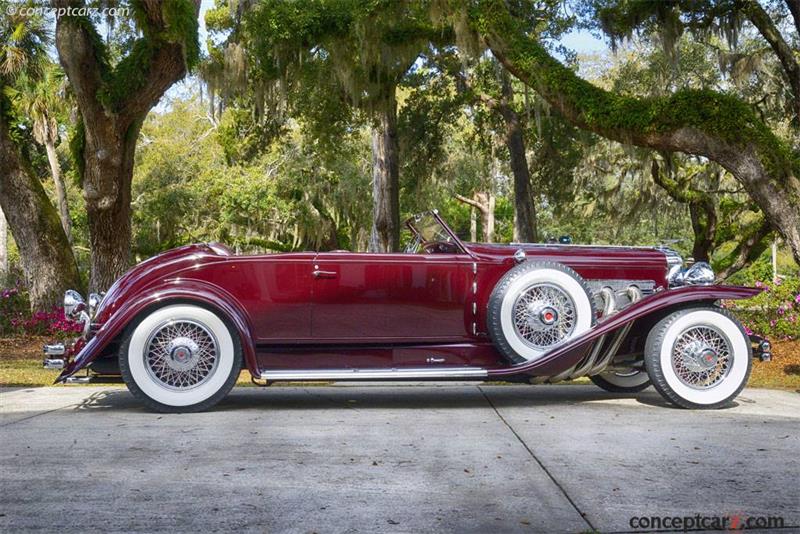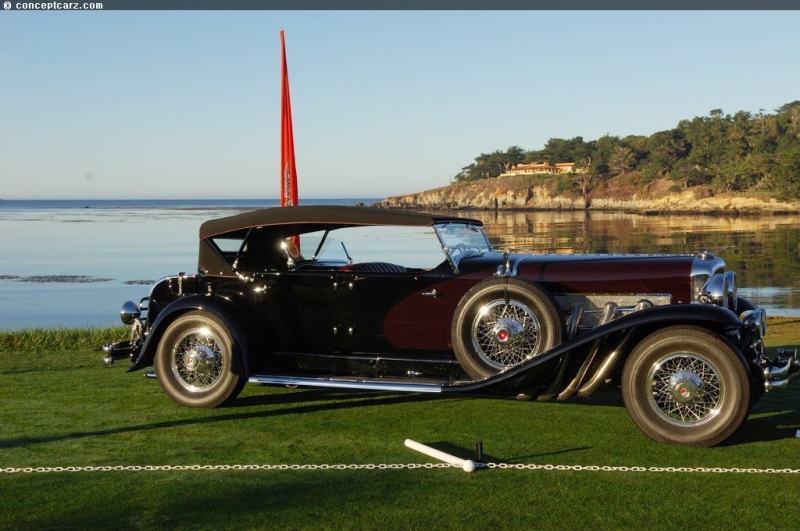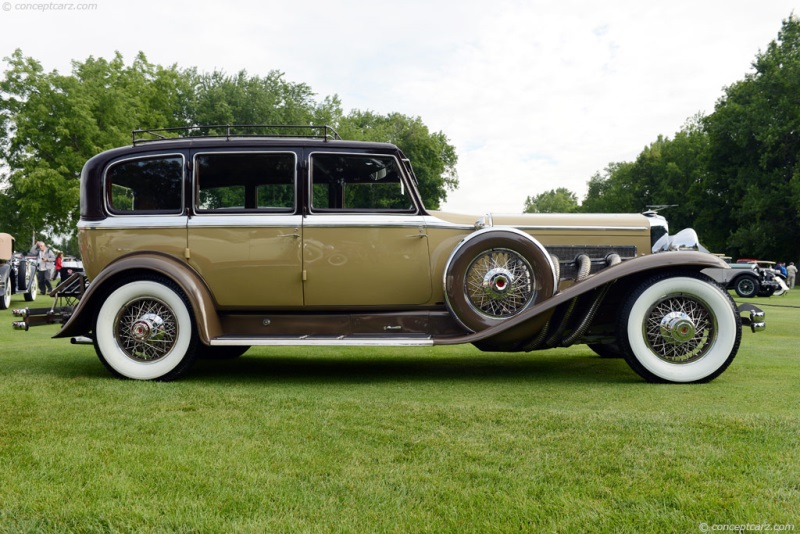The announcement of the forthcoming Duesenberg Model J halted trading on the floor of the New York Stock Exchange and would be a high-water mark of Classic era engineering and design. The advanced chassis was fitted with many leading-edge features and power was from a race-derived eight-cylinder engine with overhead cams, four valves per cylinder, and hemispherical combustion chambers developing 265 horsepower, around 100 more horsepower than its nearest competitor. The bare chassis without coachwork commanded a price of $8,500, significantly higher than nearly every full-bodied car of the era.
E.L. Cord bankrolled the Model J and from the outset designed it to be the world's finest car. The Model J was publicly introduced at the 1929 New York Auto Show with seven examples on display, with coachwork by LeBaron, Murphy, and Holbrook. It made its European debut at the 'Salon de 'lautomobile de Paris' of 1929.
Available to individual order with a Plethora of available bodies from the world's most respected and talented custom coachbuilders of the era, the delivered price of many Duesenberg Model Js approached $20,000, a staggering sum at a time when the typical new mass-produced family car cost only about $500. The regal proportions, luxury, and grand specifications inspired the popular-culture expression, 'It's a Duesy.'
Two wheelbase lengths were available, the 142.5- and 153.5-inch platforms, and carried some of the most opulent coachworks of the time. Special orders included two SSJs on shortened 125-inch platforms and a few extended to 160 inches (or longer). Power two-shoe hydraulic drum brakes were standard and eventually, an optional supercharger became available giving the engine an additional 60 horsepower. This brought the final brakes horsepower of an SJ Duesenberg equipped with a single carburetor to approximately 320 horsepower, allowing it to reach ever nearer to a top speed of 140 mph, which was over 20 mph faster than a naturally aspirated example. Just 36 cars left the factory with the optional supercharger.
The Model J included a fully automatic chassis lubrication system that operated every 30 to 60 miles. Mechanically timed lights on the dash reminded the driver when to change the oil and inspect the battery. There was complete instrumentation with a 150-mph speedometer, a tachometer, an altimeter, an eight-day clock with a split-second stopwatch hand, and more.
The Model J received minor modifications during its production lifespan, with the first major update being the replacement of the four-speed gearbox, which proved unable to cope with the engine's power. It was replaced by an unsynchronised three-speed gearbox, subsequently fitted to all Duesenbergs.
Duenber's chief body designer, Gordon Buehrig, devised coachwork for about half the Model Js built and constructed under the name La Grande by company branches in New York City, Chicago, Denver, Florida, and Los Angeles, as well as by smaller dealers. The rest received custom coachwork from independent U.S. and European coachbuilders. LeBaron bodied 38 examples of the Model J, with 28 of those being the Ralph Roberts-designed Dual Cowl Phaeton with two-tone coachwork. The Walter M. Murphy Company of Pasadena, California produced approximately 60 Convertible Coupe bodies for the Model J chassis. Early examples of this design included a top that folded down into a low pile that was exposed behind the driver's seat in the fashion of most convertibles of the era. Around 25 of these were produced, followed by mostly one-off designs, in which the top folded down into a well behind the seat and covered by a low leather tonneau secured by button snaps. This design and configuration evolved into a true 'disappearing top' model, where a flush-fitting metal lid replaced the tonneau, producing a smooth, flat line that ran from the edges of the hood to the door and down over the rear deck. Another Murphy design feature was the signature thin 'Clear-Vision' window pillars and disappearing side windows.
The Model J was introduced in 1928 and sold through 1937, with a supercharger after 1932. Most chassis and engines were built in 1929 and 1930, but due to the steep cost and the Great Depression, they were sold and bodied throughout subsequent years. A total of 481 examples of the Model J (all versions) were built with about 378 surviving examples. After 1937, Cord's financial empire collapsed. However, two additional Duesenbergs were completed between 1937 and 1940, with the final example being assembled from leftover parts.
by Daniel Vaughan | Mar 2020
E.L. Cord bankrolled the Model J and from the outset designed it to be the world's finest car. The Model J was publicly introduced at the 1929 New York Auto Show with seven examples on display, with coachwork by LeBaron, Murphy, and Holbrook. It made its European debut at the 'Salon de 'lautomobile de Paris' of 1929.
Available to individual order with a Plethora of available bodies from the world's most respected and talented custom coachbuilders of the era, the delivered price of many Duesenberg Model Js approached $20,000, a staggering sum at a time when the typical new mass-produced family car cost only about $500. The regal proportions, luxury, and grand specifications inspired the popular-culture expression, 'It's a Duesy.'
Two wheelbase lengths were available, the 142.5- and 153.5-inch platforms, and carried some of the most opulent coachworks of the time. Special orders included two SSJs on shortened 125-inch platforms and a few extended to 160 inches (or longer). Power two-shoe hydraulic drum brakes were standard and eventually, an optional supercharger became available giving the engine an additional 60 horsepower. This brought the final brakes horsepower of an SJ Duesenberg equipped with a single carburetor to approximately 320 horsepower, allowing it to reach ever nearer to a top speed of 140 mph, which was over 20 mph faster than a naturally aspirated example. Just 36 cars left the factory with the optional supercharger.
The Model J included a fully automatic chassis lubrication system that operated every 30 to 60 miles. Mechanically timed lights on the dash reminded the driver when to change the oil and inspect the battery. There was complete instrumentation with a 150-mph speedometer, a tachometer, an altimeter, an eight-day clock with a split-second stopwatch hand, and more.
The Model J received minor modifications during its production lifespan, with the first major update being the replacement of the four-speed gearbox, which proved unable to cope with the engine's power. It was replaced by an unsynchronised three-speed gearbox, subsequently fitted to all Duesenbergs.
Duenber's chief body designer, Gordon Buehrig, devised coachwork for about half the Model Js built and constructed under the name La Grande by company branches in New York City, Chicago, Denver, Florida, and Los Angeles, as well as by smaller dealers. The rest received custom coachwork from independent U.S. and European coachbuilders. LeBaron bodied 38 examples of the Model J, with 28 of those being the Ralph Roberts-designed Dual Cowl Phaeton with two-tone coachwork. The Walter M. Murphy Company of Pasadena, California produced approximately 60 Convertible Coupe bodies for the Model J chassis. Early examples of this design included a top that folded down into a low pile that was exposed behind the driver's seat in the fashion of most convertibles of the era. Around 25 of these were produced, followed by mostly one-off designs, in which the top folded down into a well behind the seat and covered by a low leather tonneau secured by button snaps. This design and configuration evolved into a true 'disappearing top' model, where a flush-fitting metal lid replaced the tonneau, producing a smooth, flat line that ran from the edges of the hood to the door and down over the rear deck. Another Murphy design feature was the signature thin 'Clear-Vision' window pillars and disappearing side windows.
The Model J was introduced in 1928 and sold through 1937, with a supercharger after 1932. Most chassis and engines were built in 1929 and 1930, but due to the steep cost and the Great Depression, they were sold and bodied throughout subsequent years. A total of 481 examples of the Model J (all versions) were built with about 378 surviving examples. After 1937, Cord's financial empire collapsed. However, two additional Duesenbergs were completed between 1937 and 1940, with the final example being assembled from leftover parts.
by Daniel Vaughan | Mar 2020
Background
The Duesenberg Company produced high-end, luxury automobiles and racing cars from 1913 through 1937. It was created by the Duesenberg brothers, Fred and August, who formed the Duesenberg Automobile %26 Motors Company, Inc. in Des Moines, Iowa with the intent on building sports cars. Just like many of their time, they were mostly self-taught engineers and had only constructed experimental cars up to....
Continue Reading >>
Continue Reading >>
1934 Duesenberg Model SJ Vehicle Profiles
Recent Vehicle Additions
Performance and Specification Comparison
Model SJ Specification Comparison by Year
Year
Production
Wheelbase
Engine
Prices
Related Automotive News

RM Auctions Amelia Island Preview - 2014
0
RM Auctions, the worlds largest auction house for investment-quality automobiles, will hold its Amelia Island, Florida, sale on March 8th at the Ritz-Carlton.
As the official auction house of the Amelia Island Concours dElegance, RMs...

Past Best of Show Winners at The Pebble Beach Concours d'Elegance
overview1
The 70th anniversary of the Pebble Beach Concours dElegance was celebrated with a spectacular display of previous Best of Show winners. Thirty-seven examples graced the showfield and many were still with the same owners who raised the trophy...

Elegance at The Quail, A Motorsport Gathering
Among the most elegant vehicles at this years The Quail, A Motorsport Gathering - in our opinion - were the 1931 Duesenberg Model J, a Horch 853, and the Mercedes-Benz 540K.
The Duesenberg
The Model J was the most powerful...

Alfa Romeo Named Best of Show at the 68th Pebble Beach Concours d'Elegance
Touring-Bodied Alfa Romeo 8C 2900B Named Best of Show at the 68th Pebble Beach Concours dElegance
PEBBLE BEACH, Calif. (August 26, 2018) — After an intense competition that drew diverse cars from around the globe, the coveted gold Best of Show...

RM Auctions Amelia Island Preview - 2014
0
RM Auctions, the worlds largest auction house for investment-quality automobiles, will hold its Amelia Island, Florida, sale on March 8th at the Ritz-Carlton.
As the official auction house of the Amelia Island Concours dElegance, RMs...

Two Best of Show Winners : Similar Designs : Same Owner
When these two vehicles won Best of Show honors at major Concours dElegance events, they both were owned by Judge Joseph Cassini III. The green colored Chrysler 4 door Phaeton with tan convertible top wears coachwork by LeBaron. In 2012, it won the...



























